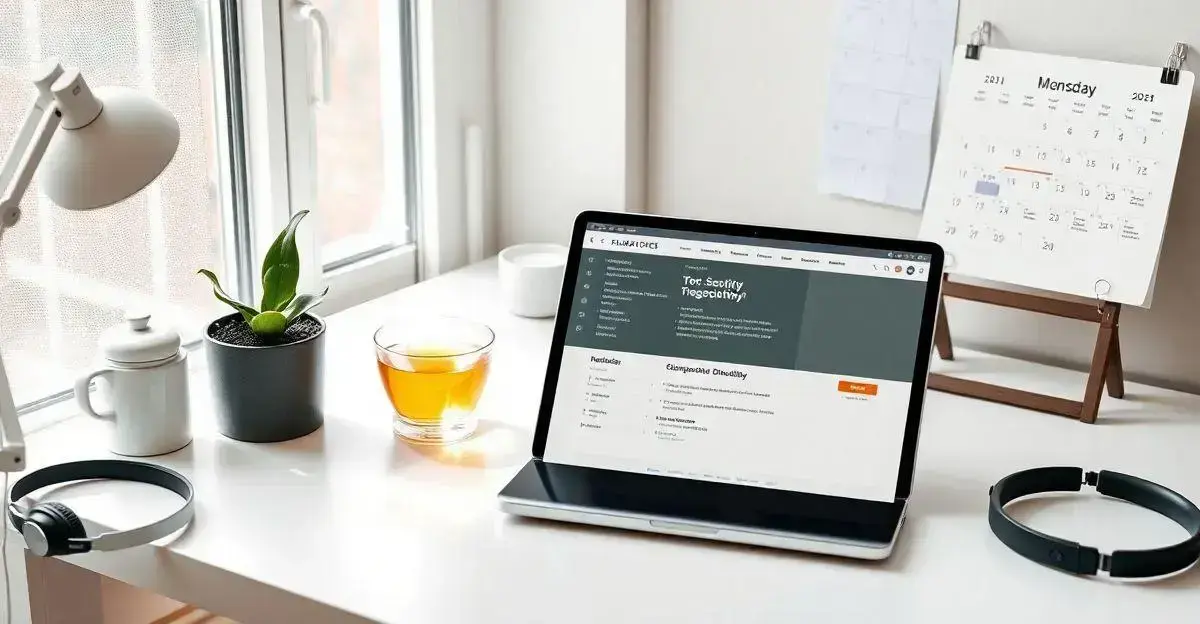Productivity tips can transform your daily routine, making the difference between a chaotic day and a successful one.
By implementing key strategies, you not only enhance efficiency but also improve your work-life balance.
Understanding Productivity
Understanding productivity is essential for achieving your goals and improving efficiency. It’s not just about working harder but working smarter, effectively using your time and resources to produce desired outcomes.
To boost productivity, start by identifying your most important tasks. Prioritize activities that offer the highest return on your time investment. Setting realistic goals keeps you focused and motivated, ensuring steady progress.
Managing energy levels is another critical factor. Identify when you’re most alert and tackle challenging tasks during those peak times. Regular breaks are also vital to prevent burnout and maintain focus. Tracking your progress provides insights into your productivity patterns, allowing you to adjust routines as needed.
Lastly, embrace flexibility. Adapting to changing circumstances and finding strategies that work for you is often the key to sustained productivity.
The Importance of Time Management

Time management is a critical skill that can significantly enhance productivity in both personal and professional settings. Effective time management allows individuals to allocate their hours wisely, ensuring that priority tasks are completed efficiently and effectively. By organizing your time, you can achieve more in a shorter period, leading to more free time for relaxation and leisure.
One of the first steps in mastering time management is to set clear goals. Determine what you want to accomplish on a daily, weekly, or monthly basis. With specific goals in mind, it becomes easier to develop a structured plan. Use tools like checklists or planners to outline your tasks.
Another essential technique is to identify your most productive hours. People often have varying energy levels throughout the day; some are more focused in the morning, while others may peak in the afternoon or evening. By scheduling your most important tasks during these peak times, you can maximize your output.
Additionally, prioritizing your tasks is vital. Not all tasks are created equal, and identifying which ones hold the greatest importance can streamline your workflow. Consider using techniques like the Eisenhower Matrix to categorize tasks based on urgency and importance.
Lastly, be sure to maintain a balance. While managing your time effectively is important, equally crucial is ensuring that you do not overexert yourself. Adequate breaks and downtime are necessary to recharge and maintain high levels of productivity over time.
Setting Effective Goals
Setting effective goals is crucial for boosting productivity and achieving success. Goals provide direction and purpose, helping you focus on what truly matters. Using the SMART framework—Specific, Measurable, Achievable, Relevant, and Time-bound—ensures your goals are clear and actionable.
Start by making your goals specific. For instance, instead of saying, “I want to be healthier,” define it as, “I will exercise for 30 minutes five days a week.” Specificity provides clarity on what needs to be done.
Ensure your goals are measurable so you can track progress and celebrate milestones. This keeps you motivated and aware of your achievements along the way.
Your goals should also be achievable. While it’s good to challenge yourself, setting realistic goals prevents frustration and encourages steady progress. Assess your current situation to choose goals that are ambitious yet attainable.
Relevance is another key factor. Your goals should align with your overall objectives and personal values to maintain motivation and commitment.
Finally, establish a time frame to create accountability. For example, “I will complete this project by the end of the month” provides a clear deadline to work toward.
By following these steps, you can set effective goals that enhance productivity and keep you on track to success.
Eliminating Distractions

Eliminating distractions is essential for enhancing productivity and maintaining focus on your tasks. In today’s fast-paced world, distractions are everywhere, from smartphones to social media and noisy environments. To improve your focus, begin by identifying the main distractions that hinder your productivity.
A good first step is to create a dedicated workspace. Find a quiet area where you can work without interruptions. This space should be comfortable and free from clutter. Once your workspace is set up, keep it consistent to signal your brain that it’s time to focus.
Limiting technology distractions is crucial. Consider using apps that block distracting websites during work hours. You can also turn off non-essential notifications on your phone to minimise interruptions. Schedule specific times for checking emails and messages instead of constantly checking throughout the day.
Moreover, it’s important to set clear boundaries with others. Communicate your work schedule to family and friends, so they understand when you need to concentrate. Having a ‘do not disturb’ signal can also help manage interruptions.
Another effective method is to practice time management strategies like the Pomodoro Technique. This involves working for a set period, usually 25 minutes, followed by a short break. This structure helps maintain focus while providing regular opportunities to recharge.
Lastly, staying organised can greatly reduce distractions. Use planners or digital tools to keep track of your tasks. By having a clear list of priorities, you can concentrate on completing one task at a time, leading to greater productivity.
Utilizing Technology Wisely
Utilizing technology wisely can significantly enhance productivity in today’s fast-paced environment. With the right tools, you can streamline processes and improve your workflow.
First, consider using project management software like Trello or Asana. These tools help you organize tasks, set deadlines, and collaborate with team members more effectively.
Another crucial aspect is leveraging automation tools. For instance, templates and automated emails can save you time on repetitive tasks. Tools like Zapier allow you to connect different apps and automate workflows, reducing manual effort.
Furthermore, using note-taking applications like Evernote or OneNote can help you keep track of ideas and important information. These apps allow you to categorize notes and find information quickly, enhancing your overall productivity.
In addition to these tools, embracing time management apps such as Todoist can keep your to-do list in check. By tracking tasks and setting priorities, you can focus on what is most important each day.
Lastly, be mindful of the digital distractions that technology can bring. While surfing the web or checking social media can be tempting, consider using website blockers during work hours to maintain focus.
By utilizing technology wisely, you can turn it into a powerful ally in achieving your productivity goals.
Creating a Productive Environment

Creating a productive environment is vital for maximizing efficiency and focus while working. To start, ensure that your workspace is clean and organized. A clutter-free desk helps reduce distractions and allows you to find what you need quickly. You can also personalize your space with items that inspire you, such as plants or motivational quotes.
Lighting is another important factor. Consider using natural light as much as possible, as it can boost your mood and energy levels. If natural light is limited, use bright, warm artificial lights to create a comfortable atmosphere.
Noise control can significantly impact productivity as well. Using noise-cancelling headphones or playing soft background music can help block out distracting sounds. Alternatively, create a designated ‘quiet time’ when colleagues are encouraged to minimise chatter.
Comfort is key in your workspace. Ensure your chair and desk are ergonomically designed to prevent discomfort while working. Take regular breaks to stretch and move around, which can help maintain your focus.
Finally, limit digital distractions by keeping your smartphone on silent and using applications that block distracting websites during work hours. By creating a productive environment, you’ll set yourself up for success and enhance your overall productivity.
Mastering Productivity: Strategies for Lasting Success
Implementing productivity strategies is essential for anyone looking to enhance their efficiency. By understanding productivity principles, managing time wisely, setting effective goals, eliminating distractions, utilizing technology appropriately, and creating a conducive work environment, you set yourself up for success.
These strategies work together to form a holistic approach to productivity. With discipline and dedication, you can transform your daily routines and achieve your objectives more effectively.
Remember, the journey to increased productivity is ongoing. Continually assess your methods and remain adaptable to new techniques that can help you reach your goals.
Check out our article on Efficient Organization to discover strategies for optimizing your workflow and boosting productivity.
